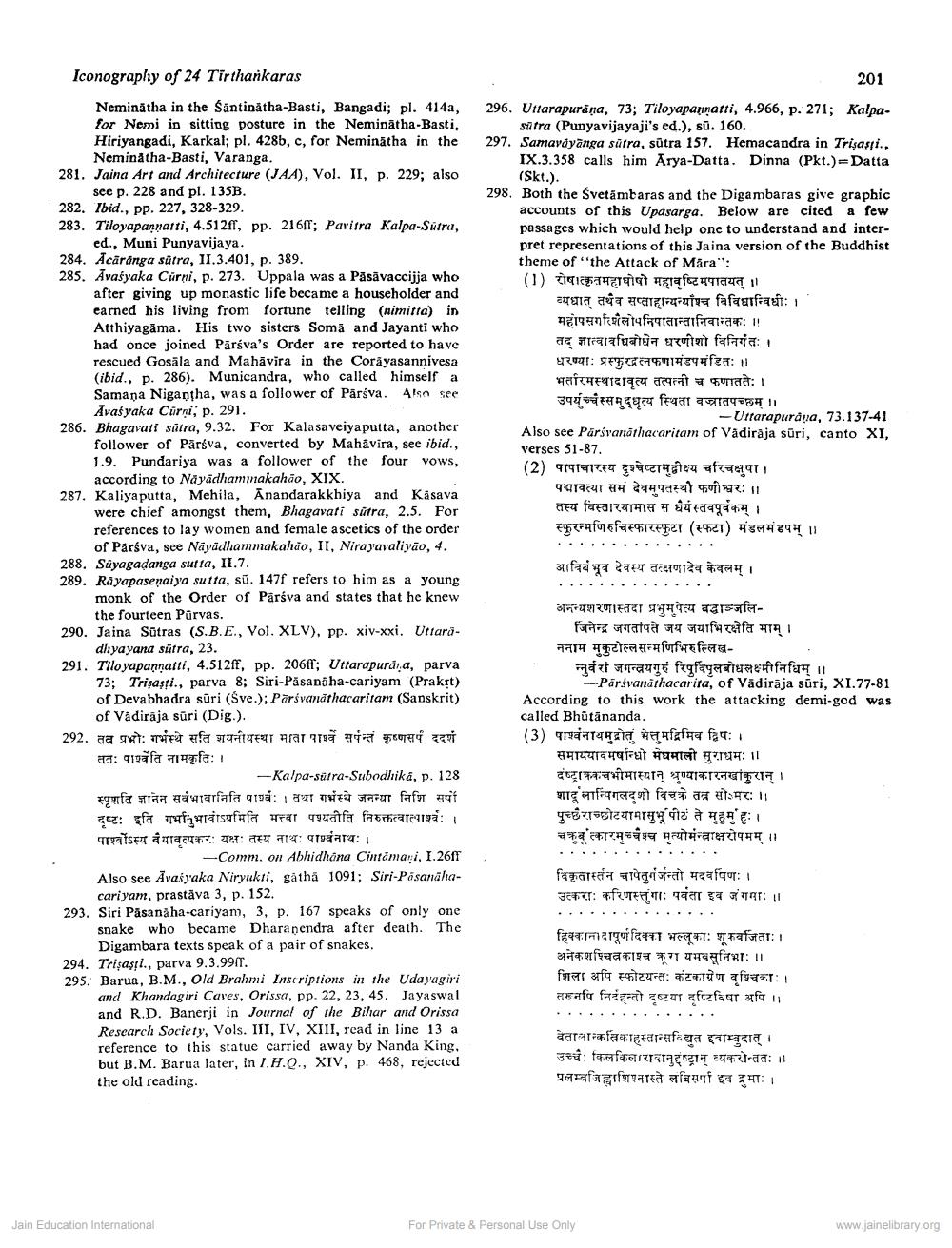________________
Iconography of 24 Tirthankaras
201
296. Uttarapurana, 73; Tiloyapannatti, 4.966, p. 271; Kalpa.
sutra (Punyavijayaji's ed.), sū. 160. 297. Samavdyānga sätra, sūtra 157. Hemacandra in Trisasi.,
IX.3.358 calls him Arya-Datta. Dinna (Pkt.) - Datta
(Skt.). 298. Both the Svetāmbaras and the Digambaras give graphic
accounts of this Upasarga. Below are cited a few passages which would help one to understand and interpret representations of this Jaina version of the Buddhist theme of "the Attack of Mara": (1) रोषात्कृतमहाघोषो महावृष्टि मपातयत् ।।
व्यधात तथैव सप्ताहान्यन्यांश्च विविधान्विधीः । महोपसदिशैलोपनिपातान्तानिवान्तकः ।। तद् ज्ञात्वावधिबोधेन धरणीशो विनिर्गतः । धरण्या: प्रस्फुरद्रत्नफणामंडपमंडितः ।। भारमस्थादावृत्य तत्पत्नी च फणाततेः । उपर्युच्चस्समद्धृत्य स्थिता बज्रातपच्छम ।।
-Uttarapurana, 73.137-41 Also see Pārsvanathacaritam of Vadiraja sūri, canto XI, verses 51-87. (2) पापाचारस्य दुश्चेष्टामवीक्ष्य चरिचक्षुपा।
पद्मावत्या समं देवमुपतस्थौ फणीश्वरः ।। तस्य विस्तारयामास स धैर्य स्तवपूर्वकम् । स्फुरन्मणिरुचिस्फारस्फुटा (स्फटा) मंडलमंहपम् ।।
आविबं भूव देवस्य तत्क्षणादेव केवलम् ।
Neminātha in the Santinatha-Basti, Bangadi; pl. 414a, for Nomi in sitting posture in the Neminatha-Basti, Hiriyangadi, Karkal; pl. 428b, c, for Neminātha in the
Neminatha-Basti, Varanga. 281. Jaina Art and Architecture (JAA), Vol. II, p. 229; also
seep. 228 and pl. 135B. 282. Tbid., pp. 227,328-329. 283. Tiloyapannatti, 4.51211, pp. 21611; Pavitra Kalpa-Sutra,
___ed., Muni Punyavijaya. 284. Acāranga satra, II.3.401, p. 389. 285. Avasyaka Cürni, p. 273. Uppala was a Pasāvaccijja who
after giving up monastic life became a householder and earned his living from fortune telling (nimitta) in Atthiyagama. His two sisters Somā and Jayanti who had once joined Pārsva's Order are reported to have rescued Gosāla and Mahavira in the Coråyasannivesa (ibid., p. 286). Municandra, who called himself a Samana Nigantha, was a follower of Pärsva. Also see
Avašyaka Cürni, p. 291. 286. Bhagavati sitra, 9.32. For Kalasaveiyaputta, another
follower of Parsva, converted by Mahavira, see ibid., 1.9. Pundariya was a follower of the four vows,
according to Nayadhammakahão, XIX. 287. Kaliyaputta, Mehila, Anandarakkhiya and Kasava
were chief amongst them, Bhagavati satra, 2.5. For references to lay women and female ascetics of the order
of Parsva, see Nāyādhammakahão, II, Nirayavaliyao, 4. 288. Sayagadanga sutta, II.7. 289. Rayapasenaiya sutta, sti. 147f refers to him as a young
monk of the Order of Parsva and states that he knew
the fourteen Parvas. 290. Jaina Sutras (S.B.E., Vol.XLV), pp. xiv-xxi, Uttara
dhyayana sutra, 23. 291. Tiloyapannatti, 4.512ff, pp. 206f1; Uttarapurára, parva
73; Trisasi., parva 8; Siri-Päsanäha-cariyam (Prakrt) of Devabhadra süri (Sve.); Pārsvanathacaritam (Sanskrit)
of Vädirāja sūri (Dig.). 292. तन्त्र प्रभोः गर्भस्थे सति शयनीयस्था माता पार्वे सर्पन्तं कृष्णसर्प ददर्श ततः पाति नामकृतिः ।
-Kalpa-satra-Subodhika, p. 128 स्पृशति ज्ञानेन सर्वभावानिति पावः । तथा गर्भस्थे जनन्या निशि सयों दृष्टः इति गर्भानुभावोऽयमिति मत्वा पश्यतीति निरुक्तत्वात्पावः । पाश्वोऽस्य यावृत्यकरः यक्षः तस्य नाथः पाश्र्वनाथः ।
-Comm. on Abhidhôna Cintamani, I.26ff Also see.Avasyaka Niryukti, gathā 1091; Siri-Pāsanaha
cariyam, prastāva 3, p. 152. 293. Siri Pasanaha-cariyam, 3, p. 167 speaks of only one
snake who became Dharanendra after death. The
Digambara texts speak of a pair of snakes. 294. Trisasti., parva 9.3.991f. 295. Barua, B.M., Old Brahmi Inscriptions in the Udayagiri
and Khandagiri Caves, Orissa, pp. 22, 23, 45. Jayaswal and R.D. Banerji in Journal of the Bihar and Orissa Research Society, Vols. III, IV, XIII, read in line 13 a reference to this statue carried away by Nanda King, but B.M. Barua later, in I.H.Q., XIV, p. 468, rejected the old reading
अनन्यशरणास्तदा प्रभुमपेत्य बद्धाञ्जलि
जिनेन्द्र जगतांपते जय जयाभिरक्षेति माम् । ननाम मुकुटोल्लसन्मणिभिरुल्लिख
नुवरां जगन्त्रयगुरुं रिपुर्विपुलबोधलक्ष्मीनिधिम् ।।।
--Pārsvanáthacarita, of Vädirāja sūri, XI.77-81 According to this work the attacking demi-god was called Bhūtānanda. (3) पाश्वनाथमुद्रोतु मेत्तु मद्रिमिव द्विपः ।
समाययावमर्षान्धो मेघमाली मुराधमः ।। दंष्ट्राक्रकचभीमास्यान् श्रृण्याकारनखांकुरान् । शार्दूलान्पिगलदृशो बिचके तन्त्र सोमरः ।। पुच्छराच्छोटयामासुभूपीट ते मुहुम हः । चऋबकारमच्चैश्च मृत्योर्मन्त्राक्षरोपमम् ।।
विकृतास्तन चापेतुर्गजन्तो मदवपिणः । उत्कराः करिणस्त्तुंगाः पर्वता इव जंगमाः ।।
हिक्कानादापूर्ण दिक्का भल्लूकाः शूकजिताः । अनेकशश्चित्र काश्च क्रूग यमवसूनिभाः ।। शिला अपि स्फोटयन्तः कंटकाग्रेण वृश्चिकाः । तम्नपि निर्दहन्तो दृष्टया दृष्टिविषा अपि ।।
बेतालान्कत्रिकाहस्तान्सविद्युत इवाम्बुदात् । उच्च: किलकिलारावानुदंष्ट्रान व्यकरोन्ततः ।। प्रलम्बजिहाशिधनास्ते लबिसर्पा इव द्रुमाः ।
Jain Education International
For Private & Personal Use Only
www.jainelibrary.org




